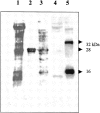Apolipoprotein AI and transthyretin as components of amyloid fibrils in a kindred with apoAI Leu178His amyloidosis
- PMID: 10854214
- PMCID: PMC1850097
- DOI: 10.1016/S0002-9440(10)65064-X
Apolipoprotein AI and transthyretin as components of amyloid fibrils in a kindred with apoAI Leu178His amyloidosis
Abstract
We found a new C-terminal amyloidogenic variant of apolipoprotein AI (apoAI), Leu178His in a French kindred, associated with cardiac and larynx amyloidosis and skin lesions with onset during the fourth decade. This single-point mutation in exon 4 of the apoAI gene was detected by DNA sequencing of polymerase chain reaction amplified material and restriction fragment length polymorphism analysis in two siblings. Blood, larynx, and skin biopsies were available from one sibling. Anti-apoAI immunoblotting of isoelectric focusing of plasma showed a +1 alteration in the charge of the protein. Extraction of fibrils from the skin biopsy revealed both full-length and N-terminal fragments of apoAI and transthyretin (TTR). ApoAI and TTR co-localized in amyloid deposits as demonstrated by immunohistochemistry. The present report, together with the first recently described C-terminal amyloidogenic variant of apoAI, Arg173Pro, shows that amyloidogenicity of apoAI is not a feature exclusive to N-terminal variants. The most striking characteristic of amyloid fibrils in Leu178His is that wild-type TTR is co-localized with apoAI in the fibrils. We have previously determined that a fraction of plasma TTR circulates in plasma bound to high-density lipoprotein and that this interaction occurs through binding to apoAI. Therefore we hypothesize that nonmutated TTR might influence deposition of apoAI as amyloid.
Figures




Similar articles
-
Hereditary hepatic and systemic amyloidosis caused by a new deletion/insertion mutation in the apolipoprotein AI gene.J Clin Invest. 1996 Jun 15;97(12):2714-21. doi: 10.1172/JCI118725. J Clin Invest. 1996. PMID: 8675681 Free PMC article.
-
A novel apolipoprotein A-1 variant, Arg173Pro, associated with cardiac and cutaneous amyloidosis.Biochem Biophys Res Commun. 1999 Apr 13;257(2):584-8. doi: 10.1006/bbrc.1999.0518. Biochem Biophys Res Commun. 1999. PMID: 10198255
-
Colocalization of apolipoprotein AI in various kinds of systemic amyloidosis.J Histochem Cytochem. 2005 Feb;53(2):237-42. doi: 10.1369/jhc.4A6387.2005. J Histochem Cytochem. 2005. PMID: 15684336
-
[Fibril-forming proteins: the amyloidosis. New hopes for a disease that cardiologists must know].Ital Heart J Suppl. 2002 Jun;3(6):590-7. Ital Heart J Suppl. 2002. PMID: 12116807 Review. Italian.
-
Apolipoprotein A-I: the dual face of a protein.FEBS Lett. 2016 Dec;590(23):4171-4179. doi: 10.1002/1873-3468.12468. Epub 2016 Nov 11. FEBS Lett. 2016. PMID: 27790714 Review.
Cited by
-
Transthyretin and the brain re-visited: is neuronal synthesis of transthyretin protective in Alzheimer's disease?Mol Neurodegener. 2011 Nov 23;6:79. doi: 10.1186/1750-1326-6-79. Mol Neurodegener. 2011. PMID: 22112803 Free PMC article. Review.
-
The Apparent Organ-Specificity of Amyloidogenic ApoA-I Variants Is Linked to Tissue-Specific Extracellular Matrix Components.Int J Mol Sci. 2022 Dec 24;24(1):318. doi: 10.3390/ijms24010318. Int J Mol Sci. 2022. PMID: 36613763 Free PMC article.
-
The amyloid interactome: Exploring protein aggregation.PLoS One. 2017 Mar 1;12(3):e0173163. doi: 10.1371/journal.pone.0173163. eCollection 2017. PLoS One. 2017. PMID: 28249044 Free PMC article.
-
Mapping the structural transition in an amyloidogenic apolipoprotein A-I.Biochemistry. 2007 Aug 28;46(34):9693-9. doi: 10.1021/bi7005493. Epub 2007 Aug 1. Biochemistry. 2007. PMID: 17665932 Free PMC article.
-
Micropurification techniques in the analysis of amyloid proteins.J Clin Pathol. 2003 Feb;56(2):86-90. doi: 10.1136/jcp.56.2.86. J Clin Pathol. 2003. PMID: 12560384 Free PMC article. Review.
References
-
- Gillmore JD, Hawkins PN, Pepys MB: Amyloidosis: a review of recent diagnostic and therapeutic developments. Br J Haematol 1997, 99:245-256 - PubMed
-
- Saraiva MJ: Transthyretin mutations in health and disease. Hum Mutat 1995, 5:191-196 - PubMed
-
- Nichols WC, Gregg RE, Brewer HB, Jr, Benson MD: A mutation in apolipoprotein A-I in the Iowa type of familial amyloidotic polyneuropathy. Genomics 1990, 8:318-323 - PubMed
-
- Benson MD, Liepnieks J, Uemichi T, Wheeler G, Correa R: Hereditary renal amyloidosis associated with a mutant fibrinogen alpha-chain. Nat Genet 1993, 3:252-255 - PubMed
Publication types
MeSH terms
Substances
LinkOut - more resources
Full Text Sources
Other Literature Sources
Medical
Research Materials
Miscellaneous

